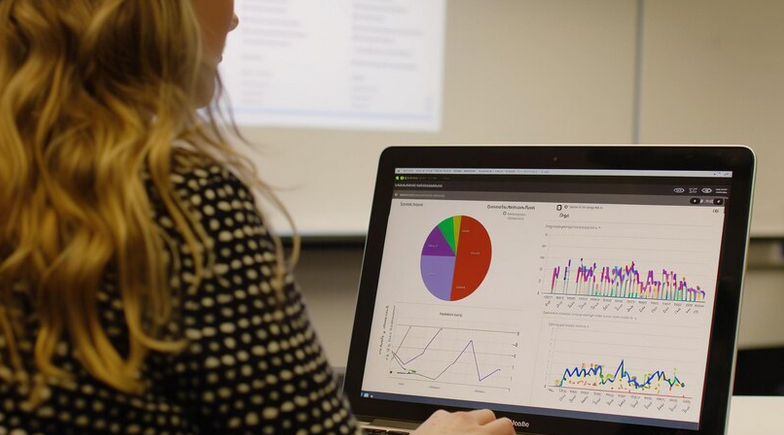How to create a media plan for an online store: Step-by-step guide
-
Rita Kochevskaya
Copywriter Elbuz
How to turn thousands of views into stable income for an online store? It all starts with a media plan. Its creation is your main weapon in the fight for customer attention. How exactly? Today I will reveal all the secrets of this unique process. Are you ready? Then let's get started!

Glossary
- 📊 Media plan - a document that lists all advertising activities for a certain period of time , their goals, objectives, deadlines, budget, promotion channels and key performance indicators (KPIs).
- 🏆 KPI (key performance indicators) - metrics and indicators used to evaluate the effectiveness of advertising campaigns and achieve set goals .
- 🔍 Target audience (TA) - a group of people to whom the online store’s advertising campaign is aimed. Includes demographic, behavioral and geographic characteristics.
- 📣 Promotion channels - platforms and means through which store advertising is carried out, such as social networks, contextual advertising, email newsletters and others.
- 🎯 Contextual advertising is a type of online advertising that is shown to the user depending on his interests and search queries.
- 🛠 A/B testing is a method of comparing two advertising options or website elements to determine the most effective one.
- 📅 Media budget - the amount of money allocated for an advertising campaign for a certain period of time.
- 📈 Forecasting is the process of predicting the results of an advertising campaign based on data analysis and statistics.
- 🎨 Creative - advertising materials created to attract the attention of the target audience (for example, banners, videos, texts).
- 🔢 Targeting - the process of selecting a target audience to display advertising based on various parameters such as age, gender, interests and behavior.
- 📊 Performance analysis - evaluation of the results of an advertising campaign in order to understand how well they correspond to the planned KPIs and what can be improved.
Effective Media Planning: Fundamentals and Objectives
Creating a media plan for an online store is a key step to a successful advertising campaign. I can say with confidence that without a well-designed plan, the budget can be wasted and the expected results will remain unachieved. A media plan is a document that includes detailed structured information about upcoming advertising campaigns. In my practice, I use it as the main analytical tool that answers two main questions: “Where do the financial resources allocated for advertising go?” and “What result does this give?”

First of all, it is important to understand that media planning differs from spontaneous advertising activities. It involves the implementation of a holistic strategy and integrated work with various channels, which allows achieving long-term effects. In one of my projects, I was faced with a limited budget, and only thanks to a well-designed media plan I was able to rationally distribute funds and achieve excellent results.
Key objectives of the media plan include:
- 🎯 Effective management budget: distribution of funds between various channels and advertising formats.
- 📈 Forecasting future traffic and ad costs: Helps you avoid unexpected costs and plan ahead for needed resources.
- 🔍 Outlining the prospects, scope and feasibility of campaigns: determining the best ways to reach the target audience.
I am convinced that each item on this list is of great importance. For example, in one of my projects I saw a significant increase in traffic after correctly forecasting the campaign, which allowed me to adjust the strategy in the right direction.
In addition, a competent media plan helps to identify the optimal channels for promotion. At one stage of working with a client, using analytical data, I came to the conclusion that certain social networks bring more conversions. This allowed me to refocus part of my budget on Facebook and increase my sales.
If you want to succeed in advertising campaigns, plan every step. I am always convinced of this from personal experience.

To ensure that the media planning process is as efficient as possible, I I recommend following these steps:
- Defining the goals and objectives of the campaign: clearly formulate what you want to achieve.
- Target audience analysis: understand who you will show advertising to.
- Selection of promotion channels: based on audience preferences.
- Content preparation: development of creatives and texts.
- Budget distribution: by selected channels and formats.
- Monitoring and adjustment of campaigns: based on analytical data.
| Actions | Reason for their importance | Recommendations |
|---|---|---|
| Defining goals and objectives | Sets the direction and focus of the campaign efforts | 🎯 State your goals clearly |
| Target audience analysis | Understanding who exactly ads are being shown to | 🔍 Study audience behavior and interests |
| Selecting promotion channels | Effective use of budgets | 📡 Determine the most effective channels |
| Content preparation | Forms an impression of the online store | ✍️ Create quality and engaging content |
| Budget allocation | Optimal use of financial resources | 💡 Apply analysis data to optimize spending |
| Monitoring and adjustment of campaigns | Provides adaptation to market changes | 🛠️ Constantly analyze and adjust strategies |
I recommend that all online store owners pay attention to attention to the importance of media planning. I hope that my experience and advice will help you create an effective advertising strategy!

Key Components of an Online Store Media Plan: My Experience
When I started developing a media plan for an online store, I realized how important it is to consider all the key components. I want to share my experience and talk about the key elements that helped me achieve success.

Selecting advertising channels
Contextual and display advertising have always played a key role in my campaigns. For example, I used Facebook and Google Search to increase my audience reach. The choice of channel always depends on the goals and target audience. At the same time, I pay attention to competitors and analyze which sites bring them the most profit.
Advertising formats
I have repeatedly been convinced that the variety of advertising formats is directly proportional to the growth of conversions. I actively used:
- 📢 Static and interactive banners
- 📢 Text Ads
- 📢 Smart Banners
- 📢 Video
This combination allowed us to reach different audience segments.

Reaches and impressions
To accurately calculate coverage, I always pay attention to the number of requests for keywords and competitor data. One of the most important parameters is number of impressions. Experience suggests that one user may receive similar advertisements up to 10 times a day.
Conversion
Conversion rates vary and depend on many factors. I use:
- Advertising system forecasts
- Online analytics services
- Previous experience
When conversions are lower than expected, I review strategies and make adjustments.
Cost per click (CPC) and CPA
Cost per click and CPA (cost per action) are important indicators for any media plan . I always analyzed previous campaigns to understand averages and make predictions. For example, after analyzing one of the campaigns, I noticed an increase in the cost per click by 20% and promptly revised the budget.
Financial Planning
Creating a budget for a media campaign involves meticulous planning. I recommend using Excel as this tool makes calculations easier and allows you to visualize data.

Council: Be sure to account for all costs, including hidden costs such as unplanned changes to strategies.
Media plan components table
| Component | Description | Usage example |
|---|---|---|
| Channels | Venues, on which advertisements are placed. | Facebook, Google Search |
| Formats | Types of advertising in which it is served to users. | Static and interactive banners, text ads, videos, posts |
| Reaches | The number of potential buyers who should see the advertising message. | Takes into account the number of requests for keywords, competitor analysis |
| Conversion | The percentage of the audience that will take the target action after viewing the ad. | Advertising system analytics, previous experience |
| CPC and CPA | Cost per click and cost of target action. | Averages from previous campaigns, forecasts |
I hope my experience and guidance will help you create an effective media plan that will produce the results you want. Never hesitate to experiment and analyze your actions to achieve the best results.
.gif)
If you need help writing your USP, check out this great guide.
Creating a media plan step by step
Step 1: Setting goals and preparing information
When I first started developing a media plan for an online store, I realized how important it was to clearly define the goals of an advertising campaign. 📈 You need to be specific and realistic. For example, instead of a simple goal to “increase sales,” I set a detailed goal: “attract 1,000 targeted leads in a month.” This allowed me to easily track success and adjust the strategy if necessary.

Start with market research. Ask yourself questions:
- 🧐 What is happening in your market segment?
- 📊 What trends are relevant today?
- 🎯 What are the needs of your target audience?
To analyze competitors, I recommend using services such as Google Trends, SimilarWeb. They will help you identify:
- Keywords that your competitors use
- Platforms and formats their advertising
- USP of competitors
- Social media activity and audience engagement
I have always strived to highlight the unique selling points of my online store, which has helped me gain a competitive advantage.
Stage 2: Selecting promotion channels
Based on the goals of your advertising campaign, select promotion channels. 
🛠️ Personally, I rely on the key criteria:
- 🎯 Presence of the target audience on the site
- 📈 Predicted click-through rates (CTR)
- 🏆 Number competitors and their activity
- 💰 Availability from a financial point of view
A detailed portrait of a potential client. I usually create it in Excel to organize data and understand where your customers spend the most time: on social networks, on specific websites, in mobile applications.
On search engines like Bing and Google, customers are looking for specific products, so it makes sense to target hot demand there. Social networks are an excellent choice for presenting a product and popularizing a brand.
Stage 3: Developing an Advertising Strategy
Determine the best way to influence potential customers. 📅 Three main strategies I used:
- Focal: advertising is placed in a localized segment and appears periodically. This is good for promotional programs on a limited budget.
- Pulsating: Ads run continuously with varying intensity. Suitable for seasonal items such as Christmas decorations or summer clothing.
- Constant: Continuous advertising with constant intensity. Ideal for brands that need to gain a foothold in the minds of consumers.
I often use a pulsing strategy to increase brand awareness and keep my audience engaged throughout the year.

Stage 4: Setting deadlines, calculations and forecasting
Once the goals and promotion channels were determined, I moved on to planning the timing of the advertising campaign. 📅 Important:
- Set the duration of the campaign in advance (usually 3 to 6 months to start, then a year)
- Assign responsible persons
- Schedule and frequency of advertising
- Predicted values of key indicators (CPA, CPC , budget)
Approximate market prices for placement and data from built-in statistics tools on advertising platforms helped me easily calculate the budget.
Stage 5: Final Plan Assembly
At this stage, I collected all the details into a single media plan. 📑 I used Google Sheets or Excel for this, which allows you to conveniently structure information and optimize the plan by month, taking into account seasonal fluctuations in demand.
On one side of the table I entered channels and advertising formats, on the other - planned indicators and budgets. This made it easier for me to track and adjust the plan as needed.
Stage 6: Working with the media plan and analyzing effectiveness
The media plan is a living document that I constantly updated and adjusted. 📈 Regular monitoring of progress and current analysis of the market situation allowed me to keep my finger on the pulse and quickly respond to any changes, be it financial problems or the need to redistribute the budget.

Periodically, I checked the effectiveness of the selected channels and adapted the format, for example, changing the placement or message. This helped me maximize my advertising impact and achieve improved results.
Overview table
| What to do 🟢 | What not to do 🔴 |
|---|---|
| Define clear, measurable goals | Ignore competitor research |
| Use diverse advertising channels | Focus on one channel |
| Adjust the plan during the process | Follow the plan without changes |
Helpful content like this, distilled from personal experiences and opinions, supports successful media planning . Don't forget to include a dynamic approach and use SWOT tables for analysis, which will allow your online store to flourish!
Main conditions for proper media planning
I believe that creating a media plan is like navigating the world of marketing, and proper planning can be your guide to success. In this section, I will discuss what steps and conditions are critical to successful media planning, based on my experience working with online retailers.

The first and key stage of media planning is collection detailed information about the target audience (TA). As I have discovered in my experience, thorough audience research allows you to fine-tune your advertising and minimize wasted budget. When I was working on a project for an online clothing store, we analyzed the demographics, interests, and behavioral characteristics of our customers. This allowed us to create personalized advertising campaigns that significantly increased conversion.
What to consider when collecting information about your target audience:
- 🌟 Demographics: age, gender, income level;
- 🌟 Geography: customer location and regional specifics;
- 🌟 Interests and behavior of: what sites they visit, what they search for, what they are interested in.
Analyze your target audience to create an accurate profile of your ideal buyer and target your ads accordingly.

After this, the important step is identification of key performance indicators (KPIs). I believe that without clear metrics it is impossible to evaluate the success of campaigns. In my practice, we always set parameters such as the number of clicks, conversion, average order value and return on advertising investment. For example, when working with one client whose goal was to increase sales by 20%, we monitored these metrics to ensure the campaign met expectations.
I recommend paying attention to the following KPIs:
- 🌟 Number of impressions and clicks ;
- 🌟 Cost per click (CPC) ;
- 🌟 Conversion ;
- 🌟 Average Order Value (AOV) ;
- 🌟 Return on Advertising Investment (ROAS).
Next, an equally important stage is searching and testing profitable sites. I learned that you can't rely on just one or two advertising platforms. For example, for one project we started with Google Ads and Facebook Ads, but along the way we realized that the audience responded better to advertising on Instagram. Constant testing and optimization allowed us to find the most effective channels for promotion.

Testing sites:
- 🌟 Google Ads ;
- 🌟 Facebook Ads ;
- 🌟 Instagram Ads ;
- 🌟 Telegram for local audience.
Finally, analysis of results during the process of launching and running a campaign is what helps to respond in a timely manner and adjust the strategy. In my experience, regular monitoring and analytics allow us to quickly identify ineffective approaches and replace them with more effective ones. Once, as part of a campaign for an online electronics store, we identified that certain ads were underperforming and quickly replaced them with new ones, which led to an increase in sales.
For successful analysis:
- 🌟 Use analytical tools (Google Analytics);
- 🌟 Check KPIs regularly ;
- 🌟 Be prepared to make changes as you go.

Tip: Keep a detailed report and record all changes so that you can later analyze their effectiveness and draw conclusions for future campaigns.
| What's useful | Don'ts |
|---|---|
| 🟢 Collect detailed data about the target audience | 🔴 Rely only on intuition |
| 🟢 Set clear KPIs | 🔴 Ignore analytical data |
| 🟢 Test different platforms | 🔴 Limit yourself to one platform |
| 🟢 Analyze results regularly | 🔴 Do not change strategy during the process |
I am confident that following these steps and criteria will help you create a successful media plan for your online store.

Experience Whiskas
Whiskas has long made a name for itself as a leading manufacturer of cat food. Their business is based on providing quality nutrition for pets, with an emphasis on natural ingredients and balanced diets. The main goal of the company is to increase sales through online stores, expand the audience and increase brand awareness.

Defining main goals and objectives
The main goals that Whiskas seeks to achieve through the media plan:
- 🟢 Increased sales of the presented product line in online stores.
- 🟢 Increasing brand awareness of among the target audience.
- 🟢 Increase interactions with potential customers across multiple platforms.
- 🟢 Expanding the audience of diseases for current and future users.
The main objective is to improve brand awareness and convert it into active sales using various digital marketing channels.
Statement of the main problem
The main problem was insufficient conversion due to low product awareness among new users, despite high interest to products from regular customers. It was necessary to develop an effective promotion strategy to attract new audiences and strengthen connections with current clients.
Characteristics and interests of the target audience
Whiskas target audience includes:
- 🐾 Cat owners who care about pet nutrition.
- 🐾 People with high demands on product quality and a penchant for choosing natural food.
- 🐾 Users who actively interact with brands on social networks and Internet platforms.
These people value the health of their pets and strive to purchase food that will ensure their long and healthy life.

Key points for potential clients
Our research has shown that potential Whiskas customers are interested in the following:
- 🔹 Ingredient quality - use of natural and healthy animal products.
- 🔹 Scientific approach - proven effectiveness of diets developed by specialists.
- 🔹 Responsiveness and trust - the presence of numerous positive reviews from other consumers.
- 🔹 Availability of products - the ability to purchase in various online stores, ease of order and delivery.
Facts, figures and concrete results of the project
Significant progress was achieved during the implementation of the media plan :
| Indicator | Before the project | After the project |
|---|---|---|
| Sales growth | +10% | +35% |
| Increased website traffic | 50,000 visits per month | 120,000 visits per month |
| Increased conversion | 1% | 3.5% |
| Increased engagement | 5,000 social interactions. networks | 15,000 interactions on social media. networks |
These data indicate the high efficiency of the developed media plan. By raising brand awareness and establishing strong connections with the target audience, Whiskas was able to significantly increase sales and attract new customers, improving conversion several times.

Frequently asked questions on the topic: How to create a media plan for an online store - Step-by-step guide
What is a media plan and why is it needed?
A media plan is a document that contains advertising strategy and tactics. It is needed to effectively allocate the budget and achieve your marketing goals.
What are the main components of a media plan?
The basic components of a media plan include goals, target audience, promotion channels, posting schedule, and budget.
What are the first steps in creating a media plan?
The first step is to define your campaign goals and gather data about your market and target audience.
How to choose suitable promotion channels?
The choice of channels depends on the profile of the target audience and the purpose of your advertising campaign. Analyze where your audience spends time and which advertising formats give the best results.
How to develop an advertising strategy?
Key messages, creative concepts and advertising formats need to be identified. It is also important to synchronize advertising materials with promotion channels.
How to set deadlines and calculate budget?
Create an advertising schedule taking into account seasonality and other factors. Distribute the budget for each stage of the campaign to make the most effective use of funds.
What steps are included in the final assembly of a media plan?
The final assembly of the media plan includes reviewing all elements of the plan, coordination with the team, and approval of the budget. It is also worth preparing a monitoring and analysis plan.
How to organize work with a media plan after launching an advertising campaign?
Regularly monitor the implementation of the plan, adjust it as necessary and analyze the effectiveness of the campaigns for further improvements.
What tools and services help in creating a media plan?
There are specialized programs and online services, such as Google Analytics, SimilarWeb and SEMrush, that help collect data and plan advertising campaigns.
How important is it to analyze the effectiveness of a media plan?
Performance analysis allows you to evaluate the results of an advertising campaign, identify successful tactics and correct shortcomings, which leads to improved subsequent campaigns and more efficient use of budget.
Thank you for reading and for your wisdom 🧠
Now you know everything about creating a successful media plan for an online store! 🚀 Your advertising campaigns will be effective and profitable. I am sure that every step we took together strengthened your experience and made you a true professional in this field. Use new knowledge and increase your income. I look forward to your comments and success stories! 💬
Author: Rita Kochevskaya, independent expert "Elbuz"
"My texts are the magic that turns ideas into automated success of an online store. Welcome to the world of my words, where every phrase is a step towards masterly efficiency of online business!"

- Glossary
- Effective Media Planning: Fundamentals and Objectives
- Key Components of an Online Store Media Plan: My Experience
- Creating a media plan step by step
- Main conditions for proper media planning
- Experience Whiskas
- Frequently asked questions on the topic: How to create a media plan for an online store - Step-by-step guide
- Thank you for reading and for your wisdom
Article Target
Help online store owners create an effective media plan for their advertising campaigns.
Target audience
Owners of online stores, marketers, advertising managers
Hashtags
Save a link to this article
Rita Kochevskaya
Copywriter ElbuzMy texts are magic that turns ideas into automated success of an online store. Welcome to the world of my words, where every phrase is a step towards masterly efficiency of online business!
Discussion of the topic – How to create a media plan for an online store: Step-by-step guide
Step-by-step instructions and tips for creating a media plan for online store advertising campaigns.
Latest comments
15 comments
Write a comment
Your email address will not be published. Required fields are checked *
























Рита Кочевская
Thank you everyone for your interest in my article! A media plan is the basis for the success of any campaign 🚀. Include examples from personal experience, and don't forget the infographics!
William Carson
Rita, great article! I was running a recent campaign for my store and the infographics really helped visualize the data. What infographic software do you recommend?
Carl Schmidt
I agree with William Carson! Data visualization always simplifies the process. Personally, I use Canva, there are huge opportunities for creativity 📊.
Isabelle Dupont
By the way, it is important to take into account seasonality and holidays when planning campaigns. The New Year was simply explosive for our store, sales doubled 🎉!
Juan Martinez
We forgot about Black Friday last year, a huge missed potential 😢. Now we plan everything in advance and cover all important dates.
Лука Россини
All these media plans are complete nonsense. It would be better to just make more discounts and everyone would buy it. Modern trends are funny and useless.
Magdalena Kowalska
Luka, discounts are good, but without a media plan you can get lost in the flow of information and not reach your target audience. 🙌
Рита Кочевская
William Carson, I recommend Canva and Piktochart for creating infographics. They are easy to use and have great functionality.
Hans Bauer
An important step for us was testing different advertising channels. It's not always obvious what works best until you try it.
Charlotte Moreau
Hans Bauer, I completely agree. We tried advertising on social networks and initially did not get results. We adjusted the strategy and everything went better!
Ольга Бровченко
Has anyone tried email newsletters? For us, this is an excellent channel for returning customers. It is only important to compose letters correctly.
Guido Rinaldi
Olga Brovchenko, yes, newsletters work great! The main thing is to segment the database so that the letters hit the target. 😉
Рита Кочевская
Great ideas, friends! Email marketing really works, but don't forget about social media remarketing. This is also a powerful tool.
Sophie Martin
Rita Kochevskaya, thanks for the advice! We are now actively engaged in remarketing, and the results so far are encouraging. What budgets do you usually allocate for this channel?
Рита Кочевская
Sophie Martin, you can allocate about 20% of your total advertising budget to remarketing. This channel shows high efficiency when configured correctly.